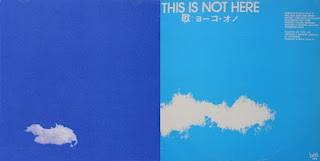Promoters John Brower and Kenny Walker (called “Brower and Walker” by the emcee, Kim Fowley) invited John and Yoko to host the Toronto Rock and Roll Revival festival. Instead, John offered to bring a band and play. So he called Eric Clapton (after George Harrison said no), bassist Klaus Voorman (a friend from their Hamburg days, who also designed the cover of “Revolver”) and Alan White (soon to join Yes), and they rehearsed on the plane from England.
The band appeared in front of 25,000 people to play John’s first solo single (“Give Peace a Chance”), “Yer Blues” (also played the previous December with Clapton and the Dirty Mac at the Rolling Stones’ Rock ‘n Roll Circus), three oldies ("Blue Suede Shoes," "Money (That's What I Want)," "Dizzy, Miss Lizzy") and his soon-to-be-recorded solo single (“Cold Turkey”), for which he read the lyrics off of a clipboard.
That’s side one of the LP; side two is Yoko’s "Don't Worry Kyoko (Mummy's Only Looking for Her Hand in the Snow)" (the b-side to “Cold Turkey”) and "John John (Let's Hope for Peace)” (from “The Wedding Album”). No one ever plays side two.
Lennon apparently mixed the album on September 25, 1969, but went back on October 20 to minimize Yoko’s vocals. Then, he had to fight with Capitol to put it out, given his previous track record of poor-selling experimental releases (“Unfinished Music No. 1: Two Virgins,” “Unfinished Music No. 2: Life with the Lions,” “The Wedding Album”). Lennon argued that putting out the LP officially would quash the bootlegs that he was certain would appear. Sure enough, a boot called "JL-YO-EC" soon hit the record racks. “Live Peace” was eventually released on December 12, hit #10 in the U.S. and went gold. It did not chart at in the UK, however. The album was in and out of print in the 1970s and 1980s, when it was part of various boxed sets. Side one was reissued as part of the excellent 1990 CD boxed set, Lennon.
The whole album was slated for CD in 1989, then scrapped, then remixed (again altering the vocals) and issued in 1995 (complete with a 1995 calendar in the booklet). The remix was released by Mobile Fidelity in 2006, with an ’06 calendar, too.
However, a search of EBay finds many reasonably priced, still sealed original vinyl copies of this album. Why? The rumor is that a huge cache of sealed copies was found in a New York City warehouse after John’s death, and they had been stashed there because John secretly bought them back in ’69 to boost the sales figures. This sounds partially plausible: Allen Klein was based in New York City (in a building that’s across from the Ed Sullivan Theater), and I have to assume he is the one who engineered the “buying-in” of the albums. Perhaps this was done at John’s request, though, since he may have remembered this trick from Brian Epstein (who reportedly did the same thing seven years earlier with the Beatles’ “Love Me Do”). Once John was murdered, Klein probably felt it was safe to let the secret out, and also to cash-in on the new wave of Beatlemania, so the albums were sent out to market.
Getting back to the original 1970 calendar, there are three types: metal-spiral-bound, plastic-spiral bound and stapled (flat). Apparently, the second two were done later to minimize damage caused by the thick metal spiral poking out of the album jacket. Eventually, Capitol did away with the calendar inside and included a postcard that the buyer filled out to have one sent in the mail. This was also the arrangement for all tape copies, since fitting a calendar into a cassette, 8-track or open-reel box was impossible. Although the calendar was for 1970, I have seen postcards also advertising a 1972 calendar. Very strange.
The front cover artwork mimics Yoko's own art for the 1958 Toshiro Mayuzumi LP, "Nirvana-Symphonia."
In a much later twist, Yoko's (seemingly) only bootleg, “This Is Not Here” (mid-80s) uses an altered version of the 1958 cover; the album includes many rare Apple cuts by Mrs. Lennon.
A couple of interesting notes: the label erroneously reads "Recorded In England" (as all Beatles releases did back then), and the album also functions as the soundtrack to John's portion of "Sweet Toronto," D.A. Pennebaker's film of the event. John's segment was excised for many years due to a dispute with Pennebaker, but it finally came out in the late 1980s. The film, though, seems to have the vocals as they were originally heard by the audience, without anyone (cough -- Yoko -- cough) being muted.


No comments:
Post a Comment